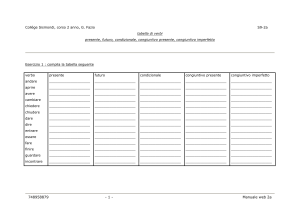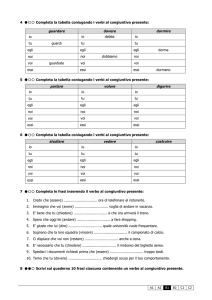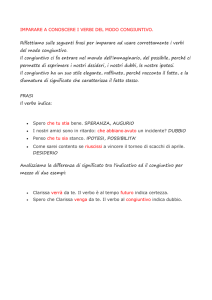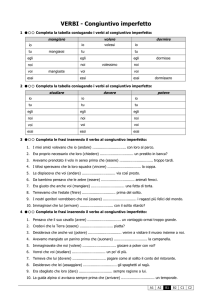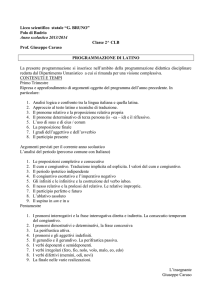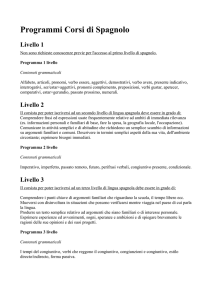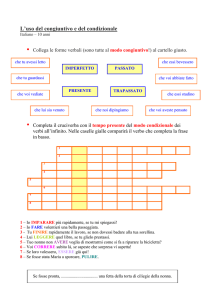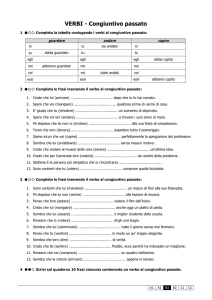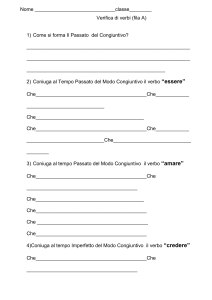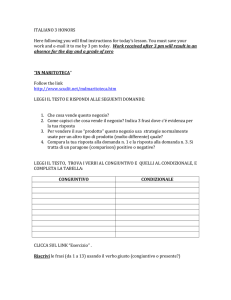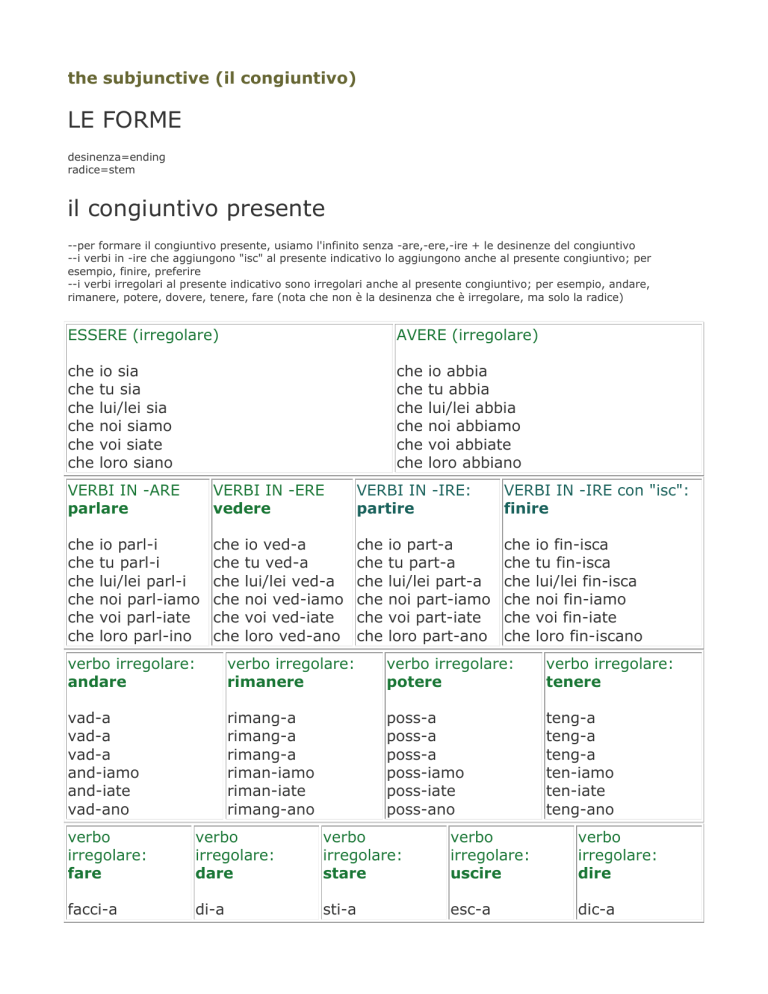
the subjunctive (il congiuntivo)
LE FORME
desinenza=ending
radice=stem
il congiuntivo presente
--per formare il congiuntivo presente, usiamo l'infinito senza -are,-ere,-ire + le desinenze del congiuntivo
--i verbi in -ire che aggiungono "isc" al presente indicativo lo aggiungono anche al presente congiuntivo; per
esempio, finire, preferire
--i verbi irregolari al presente indicativo sono irregolari anche al presente congiuntivo; per esempio, andare,
rimanere, potere, dovere, tenere, fare (nota che non è la desinenza che è irregolare, ma solo la radice)
ESSERE (irregolare)
AVERE (irregolare)
che
che
che
che
che
che
che
che
che
che
che
che
io sia
tu sia
lui/lei sia
noi siamo
voi siate
loro siano
io abbia
tu abbia
lui/lei abbia
noi abbiamo
voi abbiate
loro abbiano
VERBI IN -ARE
parlare
VERBI IN -ERE
vedere
VERBI IN -IRE:
partire
VERBI IN -IRE con "isc":
finire
che
che
che
che
che
che
che
che
che
che
che
che
che
che
che
che
che
che
che
che
che
che
che
che
io parl-i
tu parl-i
lui/lei parl-i
noi parl-iamo
voi parl-iate
loro parl-ino
io ved-a
tu ved-a
lui/lei ved-a
noi ved-iamo
voi ved-iate
loro ved-ano
io part-a
tu part-a
lui/lei part-a
noi part-iamo
voi part-iate
loro part-ano
io fin-isca
tu fin-isca
lui/lei fin-isca
noi fin-iamo
voi fin-iate
loro fin-iscano
verbo irregolare:
andare
verbo irregolare:
rimanere
verbo irregolare:
potere
verbo irregolare:
tenere
vad-a
vad-a
vad-a
and-iamo
and-iate
vad-ano
rimang-a
rimang-a
rimang-a
riman-iamo
riman-iate
rimang-ano
poss-a
poss-a
poss-a
poss-iamo
poss-iate
poss-ano
teng-a
teng-a
teng-a
ten-iamo
ten-iate
teng-ano
verbo
irregolare:
fare
verbo
irregolare:
dare
verbo
irregolare:
stare
verbo
irregolare:
uscire
verbo
irregolare:
dire
facci-a
di-a
sti-a
esc-a
dic-a
facci-a
facci-a
facc-iamo
facc-iate
facci-ano
di-a
di-a
d-iamo
d-iate
d-iano
sti-a
sti-a
st-iamo
st-iate
st-iano
esc-a
esc-a
usc-iamo
usc-iate
esc-ano
dic-a
dic-a
dic-iamo
dic-iate
dic-ano
il congiuntivo passato
--per formare il congiuntivo passato, usiamo il congiuntivo presente di avere o essere + il participio passato del
verbo
--ricordate che tutti i verbi riflessivi prendono sempre ESSERE, tutti i verbi transitivi prendono sempre AVERE, i verbi
intransitivi prendono di solito ESSERE, e le molte eccezioni dovete impararle un po' per volta
VERBI CHE PRENDONO ESSERE:
USCIRE
VERBI CHE PRENDONO AVERE:
MANGIARE
che
che
che
che
che
che
che
che
che
che
che
che
io sia uscito
tu sia uscito
lui/lei sia uscito
noi siamo usciti
voi siate usciti
loro siano usciti
io abbia mangiato
tu abbia mangiato
lui/lei abbia mangiato
noi abbiamo mangiato
voi abbiate mangiato
loro abbiano mangiato
il congiuntivo imperfetto
--the CONGIUNTIVO IMPERFETTO is formed by adding the correct endings to the root of the verb:
VERBI IN -ARE
parlare
VERBI IN -ERE
vedere
VERBI IN -IRE:
partire
che
che
che
che
che
che
che
che
che
che
che
che
che
che
che
che
che
che
io parl-assi
tu parl-assi
lui/lei parl-asse
noi parl-assimo
voi parl-aste
loro parl-assero
io ved-essi
tu ved-essi
lui/lei ved-esse
noi ved-essimo
voi ved-este
loro ved-essero
io part-issi
tu part-issi
lui/lei part-isse
noi part-issimo
voi part-iste
loro part-issero
--the verbs essere, dare, stare are irregular
ESSERE (irregolare)
DARE (irregolare)
STARE (irregolare)
che
che
che
che
che
che
che
che
che
che
che
che
io fossi
tu fossi
lui/lei fosse
noi fossimo
io dessi
tu dessi
lui/lei desse
noi dessimo
io stessi
tu stessi
lui/lei stesse
noi stessimo
che voi foste
che loro fossero
che voi deste
che loro dessero
che voi steste
che loro stessero
--the verbs bere, dire, fare, porre, trarre and tradurre have the same irregular verb stems in the congiuntivo
imperfetto as they do in the indicativo imperfetto. The verb endings are regular.
BERE
bev-essi
bev-essi
bev-esse
bev-essimo
bev-este
bev-essero
DIRE
dic-essi
dic-essi
dic-esse
dic-essimo
dic-este
dic-essero
FARE
fac-essi
fac-essi
fac-esse
fac-essimo
fac-este
fac-essero
PORRE
pon-essi
pon-essi
pon-esse
pon-essimo
pon-este
pon-essero
TRARRE
tra-essi
tra-essi
tra-esse
tra-essimo
tra-este
tra-essero
TRADURRE
traduc-essi
traduc-essi
traduc-esse
traduc-essimo
traduc-este
traduc-essero
il congiuntivo trapassato
--the CONGIUNTIVO TRAPASSATO is formed with the CONGIUNTIVO IMPERFETTO of essere or avere and the
PARTICIPIO PASSATO of the verb
--remember that all reflexive verbs always take ESSERE, all transitive verbs take AVERE, intransitive verbs usually
take ESSERE, and the many exceptions need to be learned a little at a time
che
che
che
che
che
che
io fossi andato/a
tu fossi andato/a
lei/lui fosse andata/o
noi fossimo andati/e
voi foste andati/e
loro fossero andati/e
che
che
che
che
che
che
io avessi parlato
tu avessi parlato
lui/lei avesse parlato
noi avessimo parlato
voi aveste parlato
loro avessero parlato
USES OF THE CONGIUNTIVO
when do I use the CONGIUNTIVO?
The following are the two main uses of the CONGIUNTIVO:
A. The CONGIUNTIVO is used in the secondary clause when the main clause expresses:
--emotion and fear ("ho paura/mi dispiace che i miei studenti non abbiano fatto i compiti")
--opinion and doubt ("noi professori crediamo/dubitiamo che gli studenti bevano troppo alcol")
--volition and desire ("gli studenti non vogliono/desiderano che io gli dia troppi compiti")
--necessity and importance ("é necessario/importante che voi professori capiate meglio i giovani")
--appearances and hope ("sembra/spero che questa volta tutti siano presenti in classe")
--(im)possibility and (im)probability ("é improbabile che i giovani capiscano i vecchi")
io voglio che tu studi; ma:
REMEMBER that in these cases the CONGIUNTIVO is
io voglio studiare
used only if the subjects of the two sentences are
noi siamo contenti che voi
different; otherwise, the INFINITO is used:
rimaniate; ma: noi siamo
contenti di rimanere
bisogna che lei studi di più;
ma: bisogna studiare di più
B. The CONGIUNTIVO is used after certain conjunctions:
benché, sebbene, malgrado, nonostante, quantunque (all meaning: although, in spite of, even though, even if)
purché, a patto che, a condizione che (all meaning: provided that)
nel caso che (in case)
affinché, cosicché, in modo che (all meaning: so that, in order that)
senza che (without)
prima che (before)
SEQUENCE OF TENSES:
when do I use which tense of the CONGIUNTIVO?
Usually, the tense of the CONGIUNTIVO you need depends on the tense of the verb in the main clause. The
CONGIUNTIVO almost always appear in a secondary clause. So, to know which tense of the CONGIUNTIVO you
should use, you need to (1) look at the tense of the main clause and to (2) determine whether the action described
by the CONGIUNTIVO takes place before, after, or at the same time as the action described by the tense in the main
clause. After that, it is almost automatic: you plug in the required CONGIUNTIVO according to the table below:
if the verb in the main
clause is in the:
then the congiuntivo clause is in the:
presente
congiuntivo presente
(if the action is simultaneous or future with respect to
the action of the main clause)
futuro
imperativo
congiuntivo passato
(if the action is already past with respect to the action
of the main clause)
if the verb in the main clause is in then the congiuntivo clause is in the:
the:
congiuntivo imperfetto
any past tense (passato prossimo, (if the action is simultaneous or future with
respect to the action of the main clause)
imperfetto, trapassato)
condizionale presente or passato
congiuntivo trapassato
(if the action is already past with respect to the
action of the main clause)
--remember also that after the expression "COME SE" only the CONGIUNTIVO IMPERFETTO or TRAPASSATO can be
used

